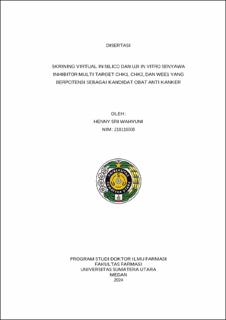Skrining Virtual In Silico dan Uji In Vitro Senyawa Inhibitor Multi Target CHK1, CHK2, dan WEE1 yang Berpotensi sebagai Kandidat Obat Anti Kanker
Virtual In Silico Screening and In Vitro Testing of Multi-Target Inhibitor Compounds of CHK1, CHK2, and WEE1 as Potential Anti-Cancer Drug Candidates

Date
2024Author
Wahyuni, Henny Sri
Advisor(s)
Masfria
Tjahjono, Daryono Hadi
Hasibuan, Poppy Anjelisa Zaitun
Metadata
Show full item recordAbstract
Breast cancer and ovarian cancer are cancers with the highest prevalence
and mortality rates in women worldwide. CHK1, CHK2, and WEE1 are molecular
pathways involved in many cancer cases. Inhibition of CHK1, CHK2, and WEE1
as checkpoints can trigger apoptosis because cells with damaged DNA will enter
mitosis without repair. Prexasertib is a selective inhibitor of CHK1 and CHK2,
while adavosertib is a selective inhibitor of WEE1. Both inhibitors have undergone
clinical trials but have side effects such as neutropenia, anemia, and hepatotoxicity.
The objective of this research is to find natural compound candidates that have the
potential to act as multi-target inhibitors against CHK1, CHK2, and WEE1 with
minimal side effects.
Potential compounds were identified through pharmacophore modeling,
followed by molecular docking and molecular dynamics. The in silico test results
were then analyzed and followed by in vitro tests to assess cytotoxic activity,
proliferation, cell cycle, apoptosis, and protein expression in 4T1 and MCF-7 cells.
The study identified six potential compounds from molecular docking and
molecular dynamics simulations. Based on interaction analysis, compounds
MCULE-6508263597-0, MCULE-1328845163-0, MCULE-3015027877-0, and
MCULE-6752415685-0 were selected for in vitro testing on 4T1 and MCF-7 cells.
Compounds MCULE-3015027877-0 and MCULE-6752415685-0 showed better
IC50 values compared to the controls, with decreased cell viability over 72 hours.
These two compounds showed activity in the S and G2M phases in both cell lines
and, in apoptosis tests, enhanced early and late apoptosis activity in both cell lines.
In protein expression tests, both compounds informed lower parent cell percentages
compared to controls and reference compounds, which indicated the inhibitory
activity of CHK1, CHK2, and WEE1.
The results of this study conclude that two compounds, identified through
pharmacophore modeling, molecular docking, molecular dynamics, and in vitro
testing, have activity as multi-target inhibitors against CHK1, CHK2, and WEE1.
